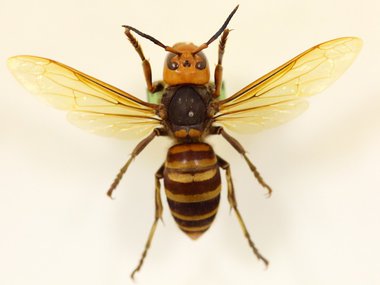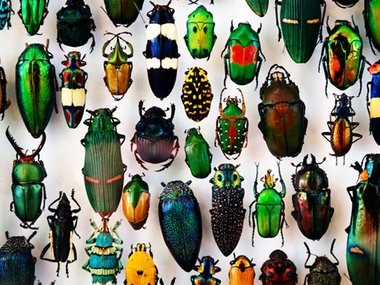Celebrate Pollinator Week by Learning More about Lepidoptera
Happy National Pollinator Week! While not an official holiday, it’s certainly worth celebrating. Animal pollinators – such as bees, moths, hummingbirds, ants, butterflies, wasps, beetles and flies – are an essential link in agriculture, helping pollinate crops and trees that produce fruits, vegetables, nuts and herbs we eat and drink (if you enjoyed a cup of coffee this morning, you have a pollinator to thank!).
Pollinators are critical to our food supply as about 35 percent of the world’s food crops depend on them to reproduce. Said another way, one out of every three bites of food we eat exists because of a pollinator.
Let’s take a look at some interesting facts about one group of pollinators: Lepidoptera.
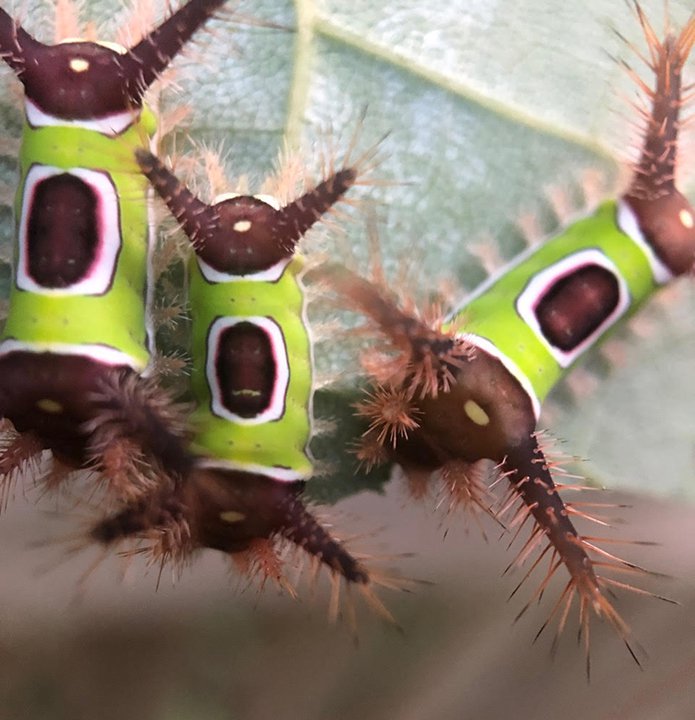
- Moths and butterflies are grouped together in the order Lepidoptera, which means scaled wings. In both moths and butterflies, all four wings are covered with hundreds, or even thousands, of microscopic plates.
- Moths typically rest with their wings open and butterflies usually rest with their wings closed. Butterflies are cold blooded (ectothermic), and will bask in the sun with their wings open. If a butterfly’s body temperature drops below 86 degrees, is it unable to fly.
- There are approximately 900,000 different kinds of known living insects in the world. Within that, some 160,000 species are moths compared to 17,500 species of butterflies. In the United States, there are nearly 11,000 moth species and around 750 butterfly species.
- Unlike butterflies, some moths do not have mouth parts as adults. All of their eating happens when they are caterpillars!
- Once the eggs hatch, the caterpillar emerges and begins to eat! All of the growing a butterfly or moth completes in its lifetime is done while it is a caterpillar; adult moths and butterflies don’t grow in size. The exoskeleton of the caterpillar does not stretch so they shed the outgrown skin, or molt, several times as they grow. These stages are called instars.
- When the caterpillar reaches its last instar, it sheds its final skin which hardens around it to become a pupa. During the pupal phase, the caterpillar undergoes complete metamorphosis – changing its body drastically from a caterpillar shape to the adult form of the butterfly or moth. The caterpillar releases digestive juices that completely break down body parts and then its cells reform into adult parts, almost like a block of ice melting and the water refreezing into a new shape.
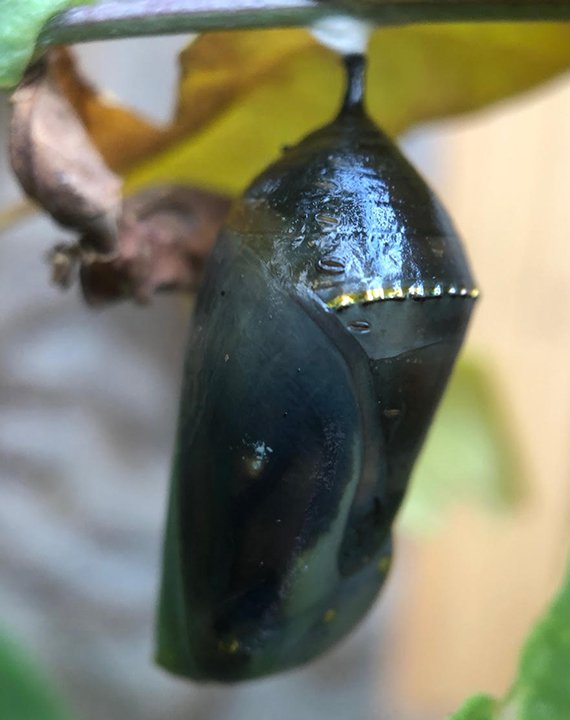
- Moths usually spin a silk cocoon around their pupal form, which is like a stringy fiber sac, while butterfly caterpillars do not. A butterfly pupa is called a chrysalis.
- The lifecycle of butterflies and moths is intimately tied into those of plants. Moth and butterfly caterpillars can be very particular about the plants they eat – some can only feed from one type of plant. This plant is known as the host plant. Adult females are able to locate the right host plant on which to lay their eggs by using taste receptors located in their legs.
- Butterflies need both host plants and nectar plants. The nectar plant’s flower is the source of food for the butterfly. Monarch caterpillars only feed on milkweed, but as butterflies they can get nectar from any flower. Some plants can be both a host plant and a nectar source.
- Caterpillars and butterflies have a complex relationship with plants. As larvae, the insect is trying to eat as much as possible to grow, and therefore can potentially damage plants that it feeds upon. But if there weren’t hungry caterpillars, we wouldn’t have beautiful lepidoptera! After the metamorphosis, butterflies and some moths are essential to plants as pollinators. They visit flowers to drink nectar, and in the process, transport pollen as they move among plants.
- In Virginia, the host plants that support the largest diversity of caterpillar species for moths and butterflies are trees, including oak (supports 500 species), cherry (350), birch (300), willow (300) and maple (250).
- Native plants support four times as many native butterfly and moth species as do introduced plants. This relationship between plants and butterflies is the result of tens of thousands of years of coevolution.
- Millions of monarch butterflies migrate to warmer climates at the end of the summer, some traveling more than 3,000 miles. Not all monarchs are capable of this southern trek: only the super generation makes that long journey. These monarchs live eight times longer (up to eight months) than their parents and grandparents and travel 10 times farther.
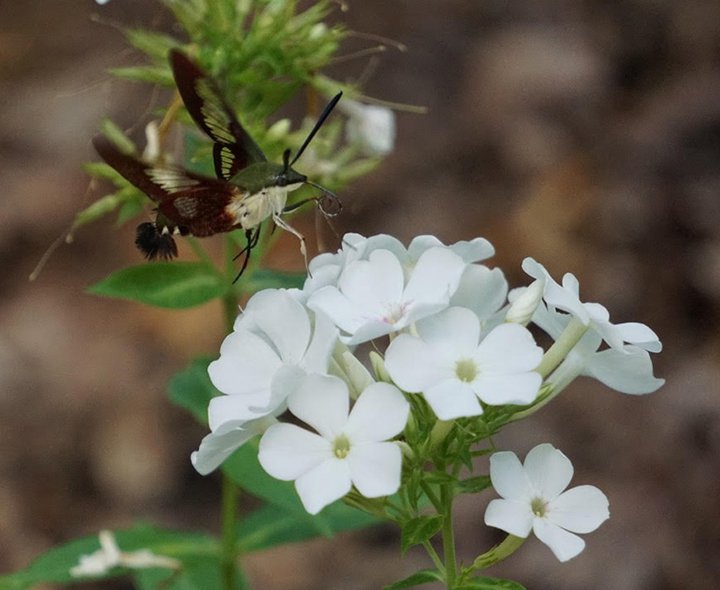
Now that you’ve learned more about caterpillars, moths and butterflies, why not head outside and see if you can find some. Since you can’t visit the Pollinator Garden we planted in 2017 thanks to support from Dominion Energy, spend some time in your backyard or go for a walk around the neighborhood looking for various lepidoptera. And guess what … making those observations has a name and, if you record them, can help scientists!
Phenology is the study of cycles in plants and animals throughout time. You, most likely, have been observing phenology for years without ever realizing it. Watching caterpillars munch on leaves that then turn into butterflies that skip from flower to flower is phenology.
Scientists can’t be everywhere all the time, so they access phenology data through records collected by the general public. This is called citizen science. If you’re outside observing phenology, you can add what you see to databases that serve as an important resource to scientists across the globe as they monitor invasive species, changes in climate, crop harvests and allergy seasons, to name a few.
The Journey North program through the University of Wisconsin-Madison Arboretum is one of the largest citizen science programs in North America. That site allows the public to report sightings of various flora and fauna, including monarch butterflies, a species that has seen drastic population decline in recent decades. If you notice monarchs in your area, enter those observations at https://journeynorth.org.
You can also download the iNaturalist app (or visit https://www.inaturalist.org) to participate in a collaborative effort to document local biodiversity. Explore the natural world, including caterpillars, moths and butterflies, and share your observations by snapping a picture and easily uploading it to the app.
If you want to go one step further, consider planting some native host and nectar plants. Ensuring these resources are available for butterflies and moths will greatly increase your chances of observing lepidoptera in your area, giving you plenty of citizen science data to share, not to mention a new appreciation for the beauty of those insects.
We can’t think of a better way to spend Pollinator Week than by discovering connections to science all around us and being inspired to contribute to more scientific understanding!
The Museum is hard at work helping you to discover your world despite dramatically reduced financial resources. If you'd like to help us continue this work, click here to learn how.
All images courtesy of @living_garden_va

